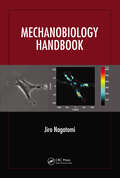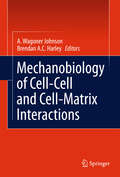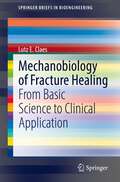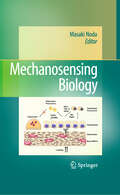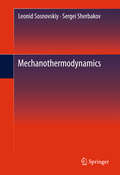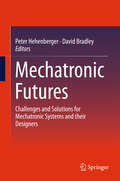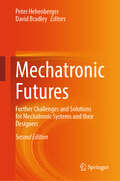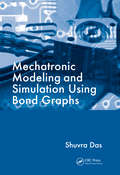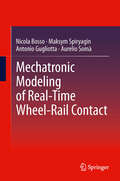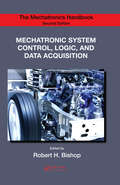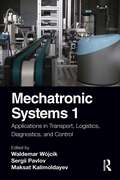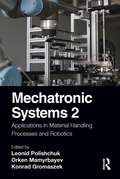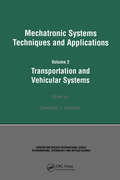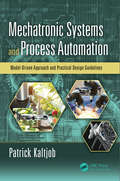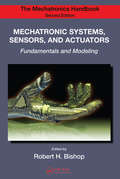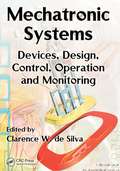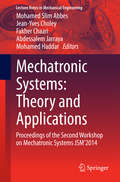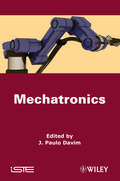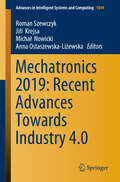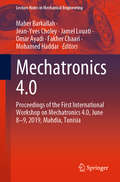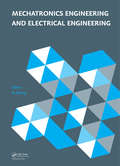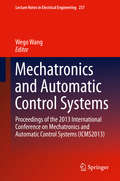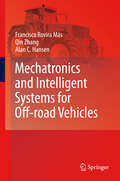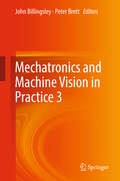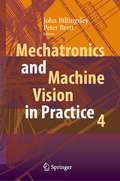- Table View
- List View
Mechanobiology Handbook
by Jiro NagatomiMechanobiology-the study of the effects of mechanical environments on the biological processes of cells-has evolved from traditional biomechanics via the incorporation of strong elements of molecular and cell biology. Currently, a broad range of organ systems are being studied by surgeons, physicians, basic scientists, and engineers. These mechanob
Mechanobiology of Cell-Cell and Cell-Matrix Interactions
by A. Wagoner Johnson Brendan HarleyMechanobiology of Cell-Matrix Interactions focuses on characterization and modeling of interactions between cells and their local extracellular environment, exploring how these interactions may mediate cell behavior. Studies of cell-matrix interactions rely on integrating engineering, (molecular and cellular) biology, and imaging disciplines. Recent advances in the field have begun to unravel our understanding of how cells gather information from their surrounding environment, and how they interrogate such information during the cell fate decision making process. Topics include adhesive and integrin-ligand interactions; extracellular influences on cell biology and behavior; cooperative mechanisms of cell-cell and cell-matrix interactions; the mechanobiology of pathological processes; (multi-scale) modeling approaches to describe the complexity or cell-matrix interactions; and quantitative methods required for such experimental and modeling studies.
Mechanobiology of Fracture Healing: From Basic Science to Clinical Application (SpringerBriefs in Bioengineering)
by Lutz E. ClaesThis book offers a summary of research on the biomechanics of fracture fixation and mechanobiology of fracture healing. The author, a known expert, provides an overview of the state of art, his own research together with that of his co-workers and collaborators; he describes the ideas and findings from the beginning of this research field in the 1960s up to the clinical consequences and applications of today. The book discusses the mechanobiology of fracture healing, illustrates the numerical methods that simulate fracture healing processes, and depicts specific research methods of experimental studies. Finally, it provides conclusions for the improvement of fracture treatment that will be of use in clinical applications nowadays. This book will be a valuable resource of knowledge for students and scientists in the field of bioengineering, experimental biology, and biomechanics, helping them to identify the correct conditions and analysis for their respective research and receive an understanding of the research field from its beginning until today. For experimental and clinical surgeons active in the field of fracture healing, this book will provide a useful historical overview over this translational research field.
Mechanosensing Biology
by Masaki NodaMechanical stress is vital to the functioning of the body, especially for tissues such as bone, muscle, heart, and vessels. It is well known that astronauts and bedridden patients suffer muscle and bone loss from lack of use. Even the heart, in pumping blood, causes mechanical stress to itself and to vascular tissue. With the loss of mechanical stress, homeostasis becomes impaired and leads to pathological conditions such as osteopenia, muscle atrophy, and vascular tissue dysfunction. In elderly populations, such mechanical pathophysiology, as well as the mechanical activities of locomotor and cardiovascular systems, is important because skeletal and heart functions decline and cause diseases in other organs. In this monograph, mechanical stress is discussed by experts in the field with respect to molecular, cellular, and tissue aspects in relation to medicine. Covering topics such as gravity and tissues and disuse osteoporosis, the book provides the most up-to-date information on cutting-edge advancements in the field of mechanobiology and is a timely contribution to research into locomotor and circulatory diseases that are major problems in contemporary society.
Mechanothermodynamics
by Leonid Sosnovskiy Sergei SherbakovThis monograph addresses the foundations of mechanothermodynamics and analyzes two of its key principles--damage of everything that exists has no conceivable limits, and effective energy (entropy) flows caused by loads of a different nature do not have a cumulative property; they interact dialectically. The authors examine a generalized model of energy and entropy states of a mechanothermodynamical medium, which generally is a continuum (liquid, gaseous) containing distributed solid deformable, and, therefore, damageable bodies, as a problem of information states of movable and damageable systems and express a solution in the first approximation. The book goes on to analyze some directions of further research in its conclusion. It is ideal for scientists, engineers, post graduate and master students of mechanics, mathematics and physics.
Mechatronic Futures
by David Bradley Peter HehenbergerOffering a comprehensive overview of the challenges, risks and options facing the future of mechatronics, this book provides insights into how these issues are currently assessed and managed. Building on the previously published book 'Mechatronics in Action,' it identifies and discusses the key issues likely to impact on future mechatronic systems. It supports mechatronics practitioners in identifying key areas in design, modeling and technology and places these in the wider context of concepts such as cyber-physical systems and the Internet of Things. For educators it considers the potential effects of developments in these areas on mechatronic course design, and ways of integrating these. Written by experts in the field, it explores topics including systems integration, design, modeling, privacy, ethics and future application domains. Highlighting novel innovation directions, it is intended for academics, engineers and students working in the field of mechatronics, particularly those developing new concepts, methods and ideas.
Mechatronic Futures: Further Challenges and Solutions for Mechatronic Systems and their Designers
by David Bradley Peter HehenbergerThis book, a new and revised edition of “Mechatronic Futures”, sets out to identify and discuss the key issues likely to impact on the design and implementation of future mechatronic systems. In doing so, it offers a comprehensive overview of the challenges, risks and options that define the future of mechatronics and provides insights into how these issues are currently being assessed and managed. The book aims to support mechatronics practitioners in identifying key areas in design, modelling and technology and to place these in the wider context of concepts such as cyber-physical systems, Digital Twins and the Internet of Things and alongside issues such as privacy, security and sustainability. For educators, it considers the potential effects of developments in these areas on mechatronic course design, and ways of integrating these. Written by experts in the field, it explores topics including systems integration, design, modelling, privacy, ethics, lifecycle monitoring, sustainability and other potential future application domains. This new edition contains many new chapters as well as updated and revised chapters from the previous edition, and takes into account how recent significant developments in artificial intelligence and cyber-security are changing how current mechatronic systems are designed, manufactured, operated, used and potentially recycled. Highlighting novel innovations and directions, the book is intended for academics, engineers, managers, researchers and students working in the field of mechatronics, particularly those developing new concepts, methods and ideas.
Mechatronic Modeling and Simulation Using Bond Graphs
by Shuvra DasBond graphs are especially well-suited for mechatronic systems, as engineering system modeling is best handled using a multidisciplinary approach. Bond graphing permits one to see the separate components of an engineering system as a unified whole, and allows these components to be categorized under a few generalized elements, even when they come f
Mechatronic Modeling of Real-Time Wheel-Rail Contact
by Aurelio Somà Nicola Bosso Maksym Spiryagin Antonio GugliottaReal-time simulations of the behaviour of a rail vehicle require realistic solutions of the wheel-rail contact problem which can work in a real-time mode. Examples of such solutions for the online mode have been well known and are implemented within standard and commercial tools for the simulation codes for rail vehicle dynamics. This book is the result of the research activities carried out by the Railway Technology Lab of the Department of Mechanical and Aerospace Engineering at Politecnico di Torino. This book presents work on the project for the development of a real-time wheel-rail contact model and provides the simulation results obtained with dSpace real-time hardware. Besides this, the implementation of the contact model for the development of a real-time model for the complex mechatronic system of a scaled test rig is presented in this book and may be useful for the further validation of the real-time contact model with experiments on a full scale test rig.
Mechatronic System Control, Logic, and Data Acquisition (The Mechatronics Handbook, Second Edition)
by Robert H. BishopThe first comprehensive and up-to-date reference on mechatronics, Robert Bishop's The Mechatronics Handbook was quickly embraced as the gold standard in the field. With updated coverage on all aspects of mechatronics, The Mechatronics Handbook, Second Edition is now available as a two-volume set. Each installment offers focused coverage of a particular area of mechatronics, supplying a convenient and flexible source of specific information. This seminal work is still the most exhaustive, state-of-the-art treatment of the field available.Focusing on the most rapidly changing areas of mechatronics, this book discusses signals and systems control, computers, logic systems, software, and data acquisition. It begins with coverage of the role of control and the role modeling in mechatronic design, setting the stage for the more fundamental discussions on signals and systems. The volume reflects the profound impact the development of not just the computer, but the microcomputer, embedded computers, and associated information technologies and software advances. The final sections explore issues surrounding computer software and data acquisition. Covers modern aspects of control design using optimization techniques from H2 theoryDiscusses the roles of adaptive and nonlinear control and neural networks and fuzzy systemsIncludes discussions of design optimization for mechatronic systems and real-time monitoring and controlFocuses on computer hardware and associated issues of logic, communication, networking, architecture, fault analysis, embedded computers, and programmable logic controllers
Mechatronic Systems 1: Applications in Transport, Logistics, Diagnostics, and Control
by Waldemar WójcikThe subject of the first volume is the issues related to the components and systems of transport machines. Motor vehicle systems tests are described: suspension dampers, steering, brakes and differentials. Design issues of machine elements operating in extreme conditions are also addressed. The possibility of increasing wear resistance in high-speed and ethanol-powered engines is analyzed. An extensive part covers the dynamics of hydraulic, electro-hydraulic and mechanical-hydraulic systems and the issues of diagnostics and automatic control in such systems. Aspects of the regional system of motor transport, public transport and transport and logistics of agricultural machinery are also addressed. The volume also examines selected technical and economic issues of gas transport. Topics on modelling of production processes with the transport of products are a complement.
Mechatronic Systems 2: Applications in Material Handling Processes and Robotics
by Leonid PolishchukThe second volume of the series is devoted to applications of mechatronics in material processing and robotics. Both classical machining methods, such as extrusion, forging and milling, and modern ones, such as plasma and ultrasonic machining, are analyzed. An extensive part covers the modeling of these processes, also from a phenomenological point of view. The study analyzes the issues related to robotics in various technological processes as well.
Mechatronic Systems Techniques and Applications (Mechatronic Systems, Techniques and Applications)
by Cornelius T. LeondesThe technical committee on mechatronics formed by the International Federation for the Theory of Machines and Mechanisms, in Prague, Czech Republic, adopted the following definition for the term: Mechatronics is the Synergistic combination of precision mechanical engineering, electronic control and systems thinking in the design products and manufa
Mechatronic Systems and Process Automation: Model-Driven Approach and Practical Design Guidelines
by Patrick O.J. KaltjobThe book discusses the concept of process automation and mechatronic system design, while offering a unified approach and methodology for the modeling, analysis, automation and control, networking, monitoring, and sensing of various machines and processes from single electrical-driven machines to large-scale industrial process operations. This step-by-step guide covers design applications from various engineering disciplines (mechanical, chemical, electrical, computer, biomedical) through real-life mechatronics problems and industrial automation case studies with topics such as manufacturing, power grid, cement production, wind generator, oil refining, incubator, etc. Provides step-by-step procedures for the modeling, analysis, control and automation, networking, monitoring, and sensing of single electrical-driven machines to large-scale industrial process operations. Presents model-based theory and practice guidelines for mechatronics system and process automation design. Includes worked examples in every chapter and numerous end-of-chapter real-life exercises, problems, and case studies.
Mechatronic Systems, Sensors, and Actuators: Fundamentals and Modeling (The Mechatronics Handbook, Second Edition)
by Robert H. BishopThis book covers the key elements of physical systems modeling, sensors and actuators, signals and systems, computers and logic systems, and software and data acquisition. It describes mathematical models of the mechanical, electrical, and fluid subsystems that comprise many mechatronic systems.
Mechatronic Systems: Devices, Design, Control, Operation and Monitoring
by Clarence W. De SilvaMechatronics has emerged as its own discipline over the past decade, yet no reference has lived up to the demands of being a working guide for designing and implementing the new generation of mechatronic systems. Uniting an international team of leading experts, Mechatronic Systems: Devices, Design, Control, Operation and Monitoring rises to the ch
Mechatronic Systems: Theory and Applications
by Mohamed Slim Abbes Jean-Yves Choley Fakher Chaari Abdessalem Jarraya Mohamed HaddarThe book offers a snapshot of the state-of-art in the field of model-based mechatronic system design. It covers topics including machine design and optimization, predictive systems in manufacturing networks, and the development of software for modeling and simulation of processes, which are supplemented by practical case studies. The book is a collection of fifteen selected contributions presented during the Workshop on Mechatronic Systems, held on March 17-19, 2014, in Mahdia, Tunisia. The workshop was jointly organized by the Laboratory of Mechanics Modeling and Production (LA2MP) of the National School of Engineers Sfax, Tunisia, and the Laboratory for Mechanical Systems and Materials Engineering (LISMMA) of Higher Institute of Mechanics (SUPMECA), Paris, France.
Mechatronics (Wiley-iste Ser.)
by J. Paolo DavimThe term Mechatronics is a combination of the words “mechanics” and “electronics”. It is the blending of mechanical, electronic, and computer engineering into an integrated design and implementation. Mechatronics systems employ microprocessors and software as well as special-purpose electronics. The main objective of this interdisciplinary engineering field is the study of automated devices (e.g. robots) from an engineering perspective, thinking about the design of products and manufacturing processes. Today, mechatronics is having a significant and increasing impact on engineering - in the design, development, and operation of engineering systems. Mechatronics systems and products are well established in a great number of industries, such as the aircraft, automotive, computer, electronics, robotics/automation, manufacturing systems, computerized machine tools, communications, and biomedical industries. This book provides details on recent advances in mechatronics, and can be used as a guidebook for final undergraduate engineering courses (for example, mechanical, electronic, computer engineering) or as a reference to the subject of mechatronics at the postgraduate level. It can also serve as a useful reference for academics, mechatronics researchers, mechanical, electronic and computer engineers, and professionals in areas related to mechatronics and robotics.
Mechatronics 2019: Recent Advances Towards Industry 4.0 (Advances in Intelligent Systems and Computing #1044)
by Roman Szewczyk Jiří Krejsa Michał Nowicki Anna Ostaszewska-LiżewskaThis book gathers papers presented at Mechatronics 2019, an international conference held in Warsaw, Poland, from September 16 to 18, 2019. The contributions discuss the numerous, multidisciplinary technological advances in the field of applied mechatronics that the emerging Industry 4.0 has already yielded. Each chapter presents a particular example of interdisciplinary theoretical knowledge, numerical modelling and simulation, or the application of artificial intelligence techniques. Further, the papers show how both software and physical devices can be incorporated into mechatronic systems to increase production efficiency and resource savings. The results and guidelines presented here will benefit both scientists and engineers looking for solutions to specific industrial and research problems.
Mechatronics 4.0: Proceedings of the First International Workshop on Mechatronics 4.0, June 8–9, 2019, Mahdia, Tunisia (Lecture Notes in Mechanical Engineering)
by Jean-Yves Choley Fakher Chaari Mohamed Haddar Maher Barkallah Jamel Louati Omar AyadiThis book gathers original findings, both theoretical and experimental, related to various cutting-edge topics in the design and modeling of mechatronic systems, including multiphysics problems. It presents peer-reviewed papers from the first installment of the Mechatronics 4.0 workshop, which was jointly organized by the Laboratory of Mechanics, Modeling and Manufacturing (LA2MP), National School of Engineers of Sfax, Tunisia, and the QUARTZ Laboratory, Higher Institute of Mechanics of Paris, SUPMECA, France. The event follows in the tradition of the Workshop on Mechatronic Systems (JSM2014), organized by the same universities, while shifting the focus to the concept of Industry 4.0. As this new type of industry is emerging as the convergence of the virtual world, digital design, and management with real-world products and objects, the chapters gathered here highlight recent work on mechatronics systems that are expected to help shape the industry of tomorrow. Thanks to a healthy balance of theory and practical findings, the book offers a timely snapshot for the research and industrial communities alike, as well as a bridge to facilitate communication and collaboration between the two groups.
Mechatronics Engineering and Electrical Engineering: Proceedings of the 2014 International Conference on Mechatronics Engineering and Electrical Engineering (CMEEE 2014), Sanya, Hainan, P.R. China, 17-19 October 2014
by Ai ShengThe 2014 International Conference on Mechatronics Engineering and Electrical Engineering (CMEEE2014) was held October 18-19, 2014 in Sanya, Hainan, China. CMEEE2014 provided a valuable opportunity for researchers, scholars and scientists to exchange their new ideas and application experiences face to face together, to establish business or research
Mechatronics and Automatic Control Systems
by Wego WangThis book examines mechatronics and automatic control systems. The book covers important emerging topics in signal processing, control theory, sensors, mechanic manufacturing systems and automation. The book presents papers from the 2013 International Conference on Mechatronics and Automatic Control Systems in Hangzhou, held in China during August 10-11, 2013.
Mechatronics and Intelligent Systems for Off-road Vehicles
by Francisco Rovira Más Alan C. Hansen Qin ZhangRapid developments in electronics over the past two decades have induced a move from purely mechanical vehicles to mechatronics design. Recent advances in computing, sensors, and information technology are pushing mobile equipment design to incorporate higher levels of automation under the novel concept of intelligent vehicles. Mechatronics and Intelligent Systems for Off-road Vehicles introduces this concept, and provides an overview of recent applications and future approaches within this field. Several case studies present real examples of vehicles designed to navigate in off-road environments typically encountered by agriculture, forestry, and construction machines. The examples analyzed describe and illustrate key features for agricultural robotics, such as automatic steering, safeguarding, mapping, and precision agriculture applications. The eight chapters include numerous figures, each designed to improve the reader's comprehension of subjects such as: * automatic steering systems; * navigation systems; * vehicle architecture; * image processing and vision; and * three-dimensional perception and localization. Mechatronics and Intelligent Systems for Off-road Vehicles will be of great interest to professional engineers and researchers in vehicle automation, robotics, and the application of artificial intelligence to mobile equipment; as well as to graduate students of mechanical, electrical, and agricultural engineering.
Mechatronics and Machine Vision in Practice 3
by John Billingsley Peter BrettIn contrast with previous books on mechatronics and machine vision in practice, a significant number of chapters focus on systems designed for human interaction and deciphering human motion. Examples illustrate assistive actuation of hip joints, the augmentation of touch sense in artificial hand prostheses and helping stroke survivors in repetitive motion therapy. Interactive mechatronics and the experience of developing machine interfaces has enabled an examination of how we use mechatronics in the service of training, and even to consider why computer games perhaps appear to capture attention so much more readily than a human instructor! Mechatronics continues to be an exciting and developing field. It is now an essential part of our world and living experience. This and the previous books in this series illustrate the journey in developing the use of mechatronics so far. We anticipate that you will find the chapters here an equal source of inspiration for new devices to solve the challenges of new applications, and of course as a resource for teaching and inspiring the new generation of mechatronics engineers.
Mechatronics and Machine Vision in Practice 4 (Robotics And Mechatronics Ser. #Vol. 4)
by John Billingsley Peter BrettThe many intriguing examples on the application of mechatronics reinforce the excitement of this creative field of technology. As a collection they present a stimulating resource to developers of future mechatronics technology, and to educators searching for interesting examples. From structured-light measurement of the build-up of detritus on railway bogies and detection of uncracked spores of Chinese medicine to a practical tractor vision guidance system embedded in a smart-phone application, the practical applications of mechatronics and machine vision abound. Fruits are counted on the tree, pasture biomass is measured and a robot collects camel dung as a resource. 3D printing is in vogue, but papers here discuss the construction and strategy of the printer itself. The measurement and analysis of myoelectric muscle signals enable a prosthesis to be controlled and a feeding robot is used for patient care. An exoskeleton has both soft and rigid links and an optical sensor analyses the tissue into which a surgical needle is being inserted. These are some of the papers in this collection from the 26th annual conference on Mechatronics and Machine Vision in Practice, carefully selected to exclude papers that are merely theoretical and to highlight those that show practical verification. Papers have been contributed from China, New Zealand, the Philippines, Emirates, Germany and of course Australia.
